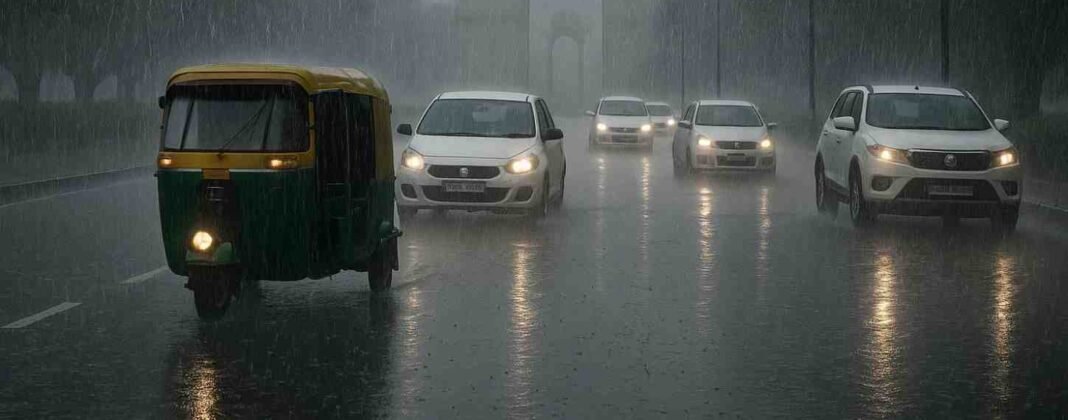Rain Lashes Delhi-NCR in Unusual August Chill
Delhi-NCR witnessed a dramatic weather turn on Sunday as heavy rain lashed Ghaziabad and Noida, leading the India Meteorological Department (IMD) to issue high-level alerts for these regions. Ghaziabad was placed under a red alert, indicating intense rainfall that could disrupt normal life, while Noida was put on an orange alert, warning of moderate to heavy showers. Interestingly, Delhi itself remained outside the alert zone, though intermittent rainfall kept the capital relatively cool for this time of year.
The alerts for Ghaziabad and Noida, issued early on Sunday morning, were valid till 11 am before being scaled down to yellow warnings, which point to isolated rainfall and milder weather conditions.
Delhi on Track for Coolest August in 13 Years
According to IMD data, August 2025 is shaping up to be Delhi’s coolest August since 2012. The average maximum temperature recorded until Saturday was 33.2°C, marginally higher than the 33.1°C of August 2012 but significantly below the readings of recent years. For comparison, August 2024 saw an average maximum of 34.1°C, while August 2023 registered a much hotter 35.4°C.
Meteorologists attribute this cooling trend to the persistent spells of moderate to heavy rain across the capital and adjoining areas. The frequent showers have not only brought down temperatures but also provided relief from the muggy conditions typical of Delhi’s monsoon.
Sunday Weather Brings Pleasant Relief
On Sunday, Delhi recorded a minimum temperature of 24.5°C, about two notches below the seasonal norm. The IMD forecast predicted a generally cloudy sky with moderate rainfall, with the maximum temperature expected to settle near 32°C. The city also reported a relative humidity of 81% at 8:30 am, indicating moist air conditions that accompanied the cooling trend.
Saturday too had been a cooler day, with the mercury dipping to 23.8°C—about 2.7°C below normal for this period. Such back-to-back dips in both maximum and minimum temperatures underline the unusual character of this monsoon month, making August 2025 stand out in Delhi’s weather records.
Impact on Daily Life and Commuting
The early morning downpour in Ghaziabad caused significant waterlogging in several low-lying areas, leading to traffic snarls and delayed commuting. Public transport systems, particularly buses, faced disruptions, while residents struggled with ankle-deep water on major roads. In Noida, rainfall intensity was slightly lower but still heavy enough to slow down vehicular movement and trigger diversions in parts of the city.
Authorities issued advisories urging commuters to avoid waterlogged routes and for residents to remain cautious of possible flooding in basements or ground-floor dwellings. However, no major damage or loss of life was reported by the local administrations of Ghaziabad or Gautam Buddh Nagar.
Monsoon Outlook for Coming Days
While Sunday brought temporary respite in Delhi with moderate rain, weather experts cautioned that the monsoon circulation remains active over North India. IMD has forecast cloudy skies and further spells of light to moderate rain for Delhi-NCR in the coming days. This could maintain the cooling effect, keeping daytime temperatures well below the seasonal average.
Meteorologists also highlighted that the monsoon performance in August has been more consistent compared to the sporadic showers of July. This sustained rainfall pattern has contributed to keeping the heat at bay and raising hopes of a prolonged period of comfortable weather for residents of the capital region.
A Rare Cool August for the Capital
Delhi’s residents are experiencing a rare August where the air feels fresh, and the oppressive humidity has been tempered by frequent showers. For many, this has meant reduced use of cooling appliances and a noticeable dip in the sweltering conditions usually associated with the monsoon months.
Although the heavy rain has occasionally caused urban flooding and traffic disruptions, the cooler temperatures have generally been welcomed across the NCR. The balance of relief and inconvenience reflects the dual character of the monsoon—bringing respite from heat but testing urban infrastructure’s resilience against sudden cloudbursts.








